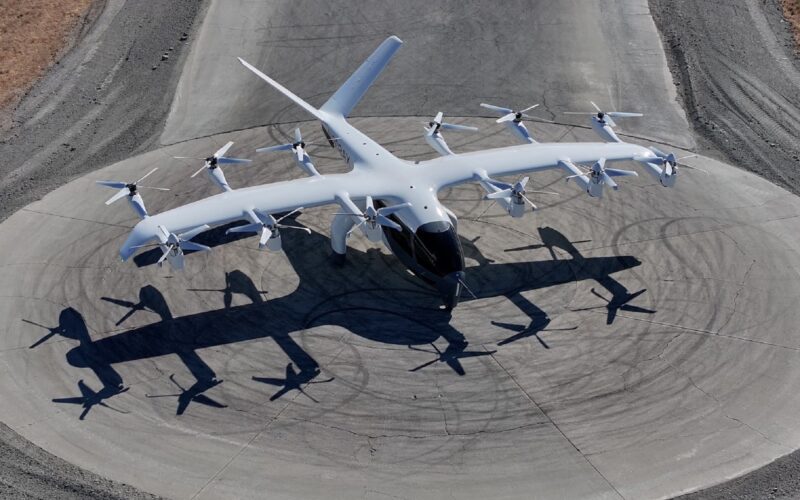Aviation
Archer Secures $580 Million Deal for Midnight eVTOL Aircraft

Archer Aviation Inc. has taken a significant step forward in the burgeoning electric vertical takeoff and landing (eVTOL) market by securing a $580 million order from Future Flight Global (FFG).
The agreement, announced today, focuses on the deployment of Archer’s Midnight eVTOL aircraft across key global markets, marking a substantial boost to Archer’s indicative order book, which now stands at approximately $6 billion.
The deal includes the planned purchase by FFG of up to 116 Midnight aircraft, each valued at an estimated $5 million. Archer’s Midnight aircraft is designed to offer passengers a sustainable, low-noise, and safe alternative to traditional ground transportation.
With the goal of transforming urban mobility, Archer aims to replace lengthy car commutes with efficient 10 to 20-minute air taxi flights, providing a viable solution to the congestion challenges faced by major cities worldwide.
Archer and FFG are now working to finalize the definitive agreements for these aircraft purchases and a broader strategic operating alliance. As part of the agreement, nearly $5 million in pre-delivery payments are expected upon completion of these agreements, underscoring the commitment of both companies to this ambitious venture.
The partnership between Archer and FFG will extend beyond aircraft sales. FFG is set to operate select routes within Archer’s planned air taxi service, leveraging Archer’s existing vertiport infrastructure network in collaboration with partners such as Signature and Atlantic Aviation. Additionally, FFG will collaborate with new vertiport partners to expand service in other high-demand locations across Southeast Asia, Europe, and the Middle East.
FFG also plans to deploy the Midnight eVTOLs for on-demand transit services tailored to high-value clients, including corporations, luxury hotels, governments, and high-net-worth individuals. This dual approach—offering both air taxi services on designated routes and exclusive on-demand transport—positions Archer and FFG at the forefront of the evolving eVTOL landscape.
To support these ambitious plans, Archer and FFG will collaborate on ecosystem development, infrastructure expansion, regulatory engagement, and demand generation. As the eVTOL industry continues to gain momentum, this partnership could be a key driver in accelerating the adoption of sustainable urban air mobility solutions globally.

Aviation
Airbus Enhances A350 Cabin with 10-Abreast Seating

Airbus has announced a new partnership with Jiatai Aircraft Equipment, a Chinese aircraft seating manufacturer, to supply upgraded economy-class seats for the A350 widebody series.
This collaboration, unveiled at the 2024 Airshow China, focuses on developing a newly designed economy seat tailored for the A350‘s New Production Standard (NPS) cabin.
One of the key features of the NPS cabin is the ability to accommodate 17-inch wide economy seats, compared to the previous 16.5-inch wide seats that airlines were limited to in the A350’s earlier configurations.
British Airways Unveils Its Brand-New First Class Cabin for the Airbus A380
This change is made possible by the expanded space in the NPS cabin, which is 35 inches longer and 4 inches wider than the previous version. This extra space is achieved by slightly moving the cockpit wall forward and shifting the rear pressure bulkhead back by one frame.
The wider cabin allows airlines to add up to 30 extra economy seats without compromising comfort. For airlines opting for a 3-4-3 seating layout, the 17-inch wide seats are an excellent choice for a more comfortable passenger experience. However, some airlines, such as Iberia, may choose to retain a 9-abreast layout with wider seats for added comfort.
The NPS cabin also offers enhanced flexibility for airline operators. One major advantage is the ability to easily switch between a 9-abreast and 10-abreast seating configuration without requiring significant downtime for aircraft reconfiguration. Airlines can use the same seat rails, tracks, and IFE interfaces, making the transition smoother and quicker.
Etihad Airways Unveils 10 Exciting New Routes for 2025
In addition, the design of the floor attachments and air-conditioning systems has been optimized for 10-abreast seating, meaning airlines can upgrade their cabins without needing to make substantial modifications to the aircraft’s structure.
Though it’s still unclear when Jiatai’s economy-class seats will be officially added to the A350’s Buyer Furnished Equipment (BFE) catalogue, the collaboration marks a significant step toward enhancing the A350’s cabin offerings.
With this partnership, Airbus is providing more seating options for airlines, ensuring that they can meet diverse customer needs while improving overall operational efficiency.
-

 Aviation2 months ago
Aviation2 months agoMicrosoft Flight Simulator Raises $3 Million to Bring Back the An-225 Mriya
-

 Airlines2 months ago
Airlines2 months agoQatar Citizens Can Travel to the United States Without a Visa
-

 Aviation2 months ago
Aviation2 months agoQatar Airways bans these new Electronic Devices on plane
-

 Airlines2 months ago
Airlines2 months agoJapan Airlines Rolls Out Free Domestic Flights to International Passengers
-

 Defence2 months ago
Defence2 months agoWhich Country Has the Largest Fleet of Fighter Aircraft?
-

 Travel2 months ago
Travel2 months agoQatar Airways Launches Four Additional Flights from Amsterdam
-

 Airport2 months ago
Airport2 months agoWestern Sydney Airport Welcomes Its First Plane After 6 Years of construction
-

 Airlines4 days ago
Airlines4 days agoDAMAC Air: Dubai’s New Luxury Airline Offers Free Flights for Registration








